| Navigation | |
Solving the GPS gap
|
Antonio Angrisano, Armando Pacifico, Mario Vultaggio
|
||||
|
The current GPS civil service provides suitable performance only in situations of good electromagnetic visibility; the positioning becomes Detailed coverage analysis of a super-constellation made up of GPS+EGNOS+S-QZSS is presented, based on existent GPS-EGNOS satellites and hypothetical Shifted- QZSS constellation over Europe. Both systems, in different way, could improve the main parameters that quantify the performance of a navigation satellite system, i.e. availability, accuracy, continuity and integrity, but their own constellations have different features and different potential uses. Fig.1: EGNOS Architecture The used indicators, to compare the various satellites configurations, are the VSN (Visible Satellites Number) and GDOP (Geometric Dilution Of Precision), which represent the quality of positioning; suchparameters are computed for a single observer and global observers grid, particularly in Europe. A statistical analysis is also introduced in order to obtain meaningful results. Moreover we will define a Service Area. BackgroundEGNOS is the European SBAS (Satellite Based Augmentation systems), it has been developed by the ESA in co-operation with the European Commission and Eurocontrol. The system is made up of 3 segments (Fig.1): Space segment, Ground segment, User segment. In this paper we are focused on space segment, which is composed by already existing GPS constellation and 3 geostationary satellites broadcasting WAD (Wide Area Differential) corrections and integrity informations. Geostationary satellites also broadcast GPS-like signal that should improve the satellites geometry. EGNOS already works, but is under final phase of testing and will be declare operative (as system) during 2008. QZSS (Quasi Zenith Satellite System) is a joint program of the JAXA and a consortium of Japanese industries; QZSS is a space-based positioning system, designed to be a GPS augmentation on urban and QZSS is composed by a Space Segment, a Ground Segment and a user segment. The Space Segment consists of three geosynchronous satellites that move on three identical Higly-inclined Elliptical Orbits (HEO) with coincident 8-shaped ground tracks centred on 135°E meridian. QZSS constellation is planned to have always at least one satellite near zenith over Japan, so that users can receive signals without obstructions in “urban canyons” and mountainous areas. Fig.2: S-QZSS satellites heights and sky-plot (observer at Naples) In order to do such simulation we use a constellation obtained by ideally shifting the QZSS constellation on Europe, changing only central longitude of ground trace (15°E). We call the simulated constellation “Shifted-QZSS” or S-QZSS to distinguish it from the original one. The The constellation is conceived to have at least one S-QZSS satellite always visible at elevation angle more than 75° from service area; SV at elevation angles of 70°-80° is usually visible for observers placed in urban canyons. Fig.3: Shifted-QZSS orbital parameters Fig.4: S-QZSS ground tracks Coverage analysisWe want to examine the worldwide and European coverage, provided by GPS and EGNOS and S-QZSS augmentation. For this purpose we have developed a simulation software in MATLAB® environment, resumed in the block diagram in Fig.5. Inputs are GPS and EGNOS Rinex navigation files, which contain the daily broadcast ephemerides. Rinex data, related to 02/16/2008, were stored by a Septentrio PolaRx2 receiver placed near Naples. The algorithm first block deals with the extraction and selection of GPS/EGNOS satellites ephemerides from Rinex files. The selected ephemerides and the theoretic S-QZSS orbital parameters are the inputs of an orbit propagator, which updates the ephemerides at observation epoch. The satellites ECEF coordinates, outputs of orbital propagator, are transformed in the local ENU coordinates and then in elevation and azimuth relative to the observer. In the last block of the software, VSN and GDOP are computed for a given mask angle. The software can work in two ways: Fig.5: Software block diagram |
||||
|
Antonio Angrisano, Armando Pacifico, Mario Vultaggio
|
||||
|
• Considering a single observer for a lot of epochs with a constant mask angle, or a masking changing versus azimuth in order to simulate a real environment. In the first mode VSN and GDOP evolutions versus time are plotted; in the second one VSN and GDOP maps are obtained for a certain area at a fixed epoch. In order to obtain more significant plots, global and regional grids of GDOP and VSN values are generated every 15 min for 24h, producing a 3D matrix of data (Fig.6). Regional resultsTo analyse the global coverage of GPS and its space-based augmentations, we consider a grid of observers placed evenly on Earth surface, with a step of 5° in latitude and longitude; VSN and GDOP are computed w.r.t. every observer at observation epoch. Mask angle values of 15°, 30° or 40° are adopted to represent different visibility conditions. To obtain a complete scenario for a fixed mask angle, probability of VSN>6 and GDOP<4.5 are estimated using a time step of 15 min for 24 hours. Thresholds VSN>6 and GDOP<4.5 are adopted as conservative conditions. With a mask angle 15° the GPS standalone provides a probability to have a VSN>6 of about 100% at polar zones and 80-90 elsewhere and provides a GDOP<4.5 probability near to 90% worldwide. Geostationary and geosynchronous augmentations in this case improve the visibility and GDOP in similar ways and the super-constellation enhances further the situation. Fig.6: Plot of 3D-grid The simultaneous use of EGNOS and S-QZSS satellites with GPS constellation provides of course the best results: VSN>6 probability is 100% and GDOP<4.5 probabilities almost 100% over Europe. At low mask angle (~15°) the standalone GPS is sufficient to guarantee good coverage performances w.r.t. availability and continuity; in this scenario, which certainly doesn’t represents the worst case, EGNOS and S-QZSS could be useful for upgrade accuracy and integrity. A mask angle 30° is a good approximation of a quite adverse but not prohibitive environment for signal propagation and PVT solution. In these conditions the VSN Fig.7: VSN>6 Probability ( mask angle 30°) of GPS constellation is rather poor, the probability to have a VSN greater than 6 is about 10-20% almost everywhere, while over polar zones is 35-40% (Fig.7). The GPS coverage situation is quite critical, in fact the GDOP<4.5 probability is about 20-30% almost everywhere and near to 0% at high latitudes where it’s impossible a precise positioning (Fig.8). The GPS+EGNOS constellation provides a considerable visibility improvement above all on the area defined by footprints intersection of 3 EGNOS SV; this area includes Southern Europe and has a VSN>6 probability about 85-95%. In this area GDOP<4.5 probability is about 50-70%. Also by the sides of this area we note a VSN between 40% and 70%, and a GDOP between 25% and 45%. Comparing with previous case the GPS+S-QZSS constellation improves the visibility in different way; a wider area takes advantages, but with worse performances. VSN>6 probability is 70-80% in Africa, 60-70% in Europe and the benefits of S-QZSS augmentation are clear at higher latitudes too. A similar Fig.8: GDOP<4.5 Probability (mask angle 30°) improvement is obtained for GDOP; GDOP<4.5 probability is 50-70% in Africa and 50-55% in Europe. The superconstellation improves the visibility in both ways: a wide area is well covered with good performances. In this case the VSN>6 probability is 100% in Africa and Southern Europe. Good GDOP coverage is also obtained; GDOP<4.5 probability is between 65% and 90% in Africa and between 60% and 70% over Europe. Fig.9: VSN>6 Probability (mask angle 30°) By the examination of Figures 9-10, which represent coverage performances over Europe with a constant mask angle 30°, we can see that in this condition GPS constellation is insufficient to provide precise positioning. The integration of GEO SVs produces a coverage improvement only over Southern Europe; on the rest of the Europe the coverage remains insufficient, owing to geostationary satellites problems to cover high latitudes. S-QZSS integration produces a good improvement in visibility and GDOP (55-70% and 40-50% respectively), but we can see some continuity issue. The GPS+EGNOS+S-QZSS super-constellation provides a full coverage on Middle and Southern Europe with a VSN>6 probability near to 100% and a GDOP<4.5 probability about 65-80%. Northern Europe is served by at least 6 SVs 60-70% of time, with a good observation geometry about 50% of time; the aforesaid coverage shortage could be overcome, handling geosynchronous orbital parameters. A common urban environment can be simply represented considering an average mask angle 30°; in this condition the superconstellation is suitable to offer good performances with reference to availabilityand continuity thanks to the visibility improvements. The coverage quality is enhanced thanks to GDOP improvement, which causes a more accurate positioning. If S-QZSS is able to broadcast EGNOSlike signals, accuracy will be further enhanced; it should give more probability to receive SBAS correction and integrity message also in urban environment. Fig.10: GDOP<4.5 Probability (mask angle 30°) GPS constellation with a mask angle 40°, is inadequate to provide a continuous and precise positioning; both VSN>6 and GDOP<4.5 probabilities are near to 0%. The super-constellation allows a good Fig.11: Naples coverage evolution (mask angle 30°) Local resultsThe developed software is able to analyse the coverage evolution for a certain period, considering a single observer; this application is useful to study in detail the behaviour of a navigation constellation over a not wide zone. Now we want to examine deeply the behaviour of GPS constellation and its augmentations over Europe; for this purpose we have selected Naples centre area to test the coverage evolutions of the considered constellations. A first analysis is made considering mask angles 15°, 30°, 40° which represent masking conditions of growing difficulty; for a fixed observer VSN and GDOP were computed every 60 seconds in a whole day and a statistical analysis with VSN>5 and GDOP<6 probability is carry out. The observer is placed at Naples at coordinates (φ: 40°50’ N; λ: 14°15’ E). With a mask angle 15° GPS standalone constellation provides good performances: VSN>5 and GDOP<6 probabilities are 100%. For the superconstellation GPS+EGNOS+S-QZSS, VSN is between 11 and 16 and the GDOP value is ever below 3.7. With a mask angle 30° (Fig.11) sometimes the only GPS has a VSN<4, so it’s impossible the determination of 3D fix; VSN>5 probability is about 40% and GDOP<6 probability is about 45%. Instead w.r.t. super-constellation, VSN is between 7 and 13, and GDOP between 2.5 and 8; |
||||
|
Antonio Angrisano, Armando Pacifico, Mario Vultaggio
|
||||||||||||||||||||||||||||||||||||
|
With a mask angle 40° GPS is inadequate to provide a continuous 3D positioning service, because very frequently there is a poor constellation coverage (VSN<4). VSN of super-constellation are between 5 and 11, so a continuous positioning service is guaranteed; the accuracy is not too good, because GDOP<6 probability is near to 40%. Fig.12: 3D model of a Naples street A further analysis is made considering a real environment rather than constant mask angle, building a 3D model of an urban area in AutoCAD (Fig.12); a map of historic centre of Naples is considered and the third dimension was obtained extruding the buildings contours with rough height values. In the 3D model three different observers are considered and for each of these VSN and GDOP are computed every 60 seconds for 24 hours. The observers (marked by blue spots on Fig.12) have different types of blocking situation; the first observer has a low masking angle (comparable to the blocking configuration with constant mask angle 15°), the second with a high masking and the third one with a very high masking angle. With a weak urban masking (observer 1 Fig.12) the GPS coverage is suitable to provide a good positioning service, the VSN is at least 5 and the GDOP value rarely exceeds 10. The augmentation constellations improve further the performances. The super-constellation works very well, the VSN is between 9 and 17 and the maximum GDOP value is about 5. With an high urban masking (obs.2 Fig.12 and results showed in Fig.13) the stand-alone GPS is not sufficient to provide good coverage performances; VSN>5 probability is near to 30% and positioning service is often cut off. In these masking conditions and with an observer at middle latitude, S-QZSS and EGNOS augmentations work differently; Fig.13: Naples coverage evolution (strong masking) With a very high urban masking (obs.3 Fig.12) the coverage performances of GPS are very poor, so the 3D position solution is often impossible or uncertain. GPS+EGNOS+S-QZSS constellation provide a continuous service but it couldn’t be guaranteed high accuracy: VSN>5 probability is near to 100% but GDOP<6 probability is about 55%. Service Area DefinitionThe obtained results encourage defining a “service area” (highlighted by ellipses in Fig.14) where both considered parameters (VSN and GDOP) reach appropriate values to guarantee availability and continuity of good satellite geometry. The following parameters have been chosen to define the service area: ConclusionsIn this paper the coverage performances of four constellations are analysed: GPS, GPS+EGNOS, GPS+S-QZSS, GPS+EGNOS+S-QZSS. Coverage is globally examined; over european region, different masking angle conditions are considered. With a not severe environment, GPS constellation provides good coverage performances. In moderately adverse environment (masking up to 35°), EGNOS and S-QZSS constellations are useful augmentations. A wide service area, including Southern Europe and Africa can be defined, where the superconstellation GPS+EGNOS+S-QZSS guarantees good performances in terms of visibility and GDOP. In the near future we wish to simulate a theoretic constellation with orbital parameters suited to improve coverage performances at high latitude. The obtained results encourage the implementation of a European program dealing with launching of some geosynchronous satellites in order to improve navigation satellite coverage over Europe. Waiting Galileo system deployment, such constellations could be used as gap-filler, or in future as backup system or as Galileo ERIS (External Region Integrity Systems) support. Fig.14: Service Area References• Japan Aerospace Exploration Agency (2007), Interface Specification for QZSS (IS-QZSS) |
||||||||||||||||||||||||||||||||||||
|
||||||||||||||||||||||||||||||||||||
|


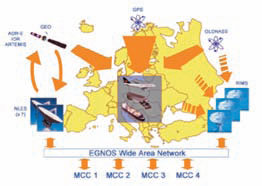
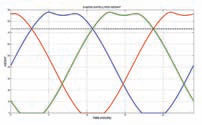
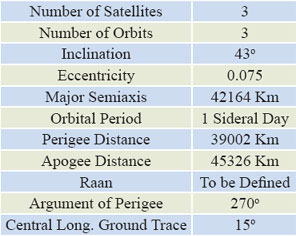

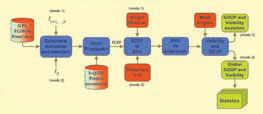
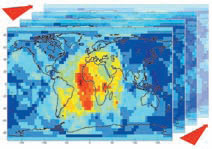
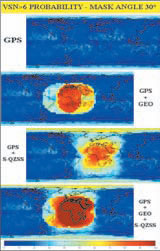

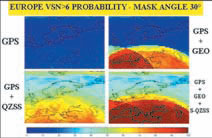
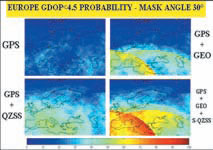
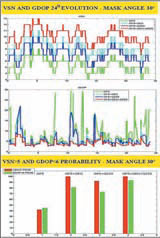
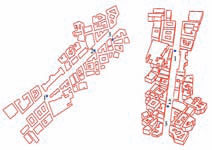
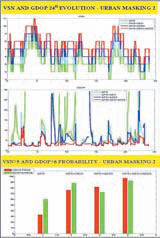
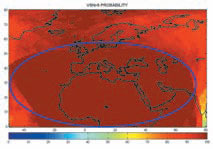













 (No Ratings Yet)
(No Ratings Yet)




